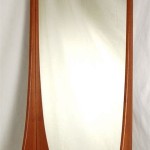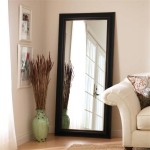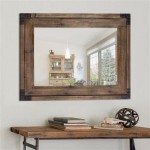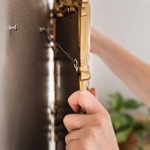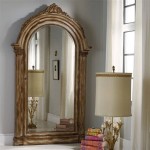Convex Mirrors in Vehicles: Enhancing Driver Awareness and Safety
Convex mirrors are a ubiquitous safety feature in vehicles, playing a crucial role in minimizing blind spots and enhancing driver awareness. Their distinctive curved surface provides a wider field of view compared to traditional flat mirrors, enabling drivers to perceive a larger area surrounding their vehicle. This broader perspective is particularly beneficial when performing maneuvers such as lane changes, merging onto highways, and parking. While convex mirrors offer significant advantages, understanding their characteristics and limitations is essential for their effective utilization and overall driving safety.
The fundamental principle behind a convex mirror's functionality lies in its geometry. The outward curvature of the reflecting surface causes light rays to diverge upon reflection. This divergence results in a diminished image size, allowing a wider area to be encompassed within the mirror's field of view. The extent of the curvature directly impacts the field of view and the degree of image distortion. A more pronounced curvature leads to a wider field of view but also increases the perceived distortion. Conversely, a flatter convex mirror will offer less distortion but a narrower field of view, approaching that of a flat mirror.
The incorporation of convex mirrors in vehicles is a direct response to the inherent limitations of flat mirrors and the blind spots they create. Blind spots are areas around a vehicle that are not visible in the standard rearview or side mirrors. These areas pose a significant safety hazard, as vehicles or pedestrians within them may go undetected, increasing the risk of collisions. Convex mirrors effectively mitigate this risk by expanding the driver's peripheral vision, allowing them to see vehicles and other objects that would otherwise be hidden in blind spots.
Key Advantages of Convex Mirrors in Vehicles
The primary advantage of convex mirrors is their ability to provide a significantly wider field of view compared to flat mirrors. This expanded perspective allows drivers to observe a larger area surrounding their vehicle, enabling them to identify potential hazards that might otherwise go unnoticed. This is particularly important in situations where quick decision-making is required, such as merging onto a busy highway or navigating through congested traffic.
By minimizing blind spots, convex mirrors contribute to a safer driving environment. The ability to see vehicles approaching from the side or rear, which would be hidden in the blind spots of flat mirrors, allows drivers to make more informed decisions when changing lanes or making turns. This reduced risk of collisions translates to increased safety for both the driver and other road users.
Convex mirrors are relatively inexpensive and easy to install, making them a cost-effective safety enhancement for vehicles. They can be added as aftermarket accessories to existing vehicles or, more commonly, are integrated as standard equipment by vehicle manufacturers. Their simplicity and affordability make them a widely accessible safety feature for drivers of all vehicle types.
Despite their benefits, convex mirrors also introduce a degree of image distortion. The curved surface compresses the image, making objects appear smaller and farther away than they actually are. This distortion can be particularly problematic when judging the distance and speed of vehicles approaching from the rear or side. Drivers must be aware of this distortion and adjust their perception accordingly to avoid misjudging distances and making unsafe maneuvers.
The perceived distance distortion is a crucial factor drivers must learn to compensate for. The distortion makes other vehicles appear farther away than they actually are. This difference in perceived and actual distances can lead to making unsafe lane changes on the highway, for example.
Another critical aspect of effectively using convex mirrors is proper adjustment. The mirrors must be positioned correctly to maximize their field of view and minimize distortion. The optimal adjustment will vary depending on the vehicle type and the driver's seating position. It is recommended that drivers take the time to adjust their convex mirrors before starting their journey, ensuring that they provide a clear and comprehensive view of the surrounding environment.
Types and Placement of Convex Mirrors in Vehicles
Convex mirrors are available in various forms and configurations, each designed for specific applications within a vehicle. The most common types include: integrated convex mirrors, add-on convex mirrors, and panoramic rearview mirrors. Integrated convex mirrors are incorporated directly into the vehicle's side mirrors, typically as a separate section at the outer edge of the mirror housing. Add-on convex mirrors are aftermarket accessories that can be attached to existing flat mirrors, providing an instant upgrade to improve visibility. Panoramic rearview mirrors are wide, convex mirrors that replace the standard rearview mirror, offering an expansive view of the rear of the vehicle.
The placement of convex mirrors is critical for their effectiveness. Side mirrors with integrated convex sections should be adjusted so that the driver can see a clear view of the adjacent lane and the area behind the vehicle. Add-on convex mirrors should be positioned to cover the blind spot areas that are not visible in the standard side mirrors. Panoramic rearview mirrors should be adjusted to provide a wide, unobstructed view of the rear of the vehicle, minimizing blind spots and maximizing awareness.
Trucks and other large commercial vehicles often utilize a combination of convex and flat mirrors to provide comprehensive visibility. These vehicles typically have large side mirrors that incorporate both flat and convex sections, as well as additional convex mirrors mounted on the front and rear of the vehicle. This multi-mirror system helps drivers of large vehicles to navigate safely in complex traffic situations and to maneuver in tight spaces.
Overcoming the Challenges of Distance Judgement
The inherent distortion of convex mirrors can pose a challenge to drivers when judging the distance and speed of other vehicles. To overcome this challenge, drivers need to develop a sense of awareness and learn to compensate for the distorted perception. This often involves a period of adjustment and practice, during which drivers learn to correlate the appearance of objects in the convex mirror with their actual distance and speed.
One technique that can aid in distance judgment is to use a combination of visual cues. By comparing the size and position of an object in the convex mirror with its appearance in the standard side or rearview mirror, drivers can gain a better understanding of its actual distance. Additionally, observing the rate at which an object is approaching or receding in the convex mirror can provide valuable information about its speed.
Another important factor is to avoid relying solely on the convex mirror for distance judgment. Drivers should always double-check their surroundings by glancing over their shoulder before making any lane changes or turns. This provides a direct visual confirmation of the position and speed of other vehicles, reducing the risk of misjudging distances and making unsafe maneuvers.
Manufacturers often include warnings on or near convex mirrors cautioning drivers that "objects in mirror are closer than they appear." This serves as a constant reminder of the distortion and encourages drivers to exercise caution when interpreting the images in the mirror. Understanding this caveat is crucial to using this safety feature effectively.
Regularly cleaning convex mirrors is essential to maintain their clarity and effectiveness. Dirt, grime, and water droplets can obscure the view and further distort the image, making it more difficult to judge distances and identify potential hazards. Regularly cleaning the mirrors with a mild cleaner and a soft cloth will ensure that they provide a clear and undistorted view of the surrounding environment.
The effectiveness of convex mirrors can be significantly reduced in poor weather conditions, such as rain, snow, or fog. In these conditions, visibility is generally impaired, and the distortion of the convex mirror can make it even more difficult to judge distances and identify hazards. In such situations, drivers should exercise extra caution and reduce their speed to allow for greater reaction time. They should also ensure that their headlights and taillights are turned on to increase their visibility to other road users.
Convex mirrors are an integral part of vehicle safety systems. Their ability to expand the driver's field of vision and minimize blind spots contributes to a safer driving environment. While they introduce a degree of image distortion, understanding their limitations and learning to compensate for them is essential for their effective utilization. By properly adjusting the mirrors, using a combination of visual cues, and exercising caution in poor weather conditions, drivers can maximize the benefits of convex mirrors and enhance their overall driving safety.

Convex And Concave Mirrors In Cars

Convex Mirrors Use Car

Concave Vs Convex Mirrors In Cars
Car 360 Wide Angle Round Convex Mirror Vehicle Side Blindspot Blind Spot Rear View Small Ee Singapore

Why Aftermarket Blind Spot Mirrors For Your Car Are Actually Unsafe Drivespark

2pcs Auto 360 Side Wide Angle Square Convex Mirror Car Vehicle Blindspot Blind Spot Rearview Small Wish

Black Heavy Duty Concave And Convex Scratch Resistant Car Side Mirror At Best In Udaipura Shri Krishna Decor

Qoo10 Auto 360 Wide Angle Round Convex Mirror Car Vehicle Side Blindspot Bli Automotive Ind

2 Pcs Auto Side 360 Wide Angle Round Convex Mirror Car Vehicle Blind Spot Dead Zone Rearview Small For Wish

Hd 360 Degree Wide Angle Adjustable Car Rear View Convex Mirror Auto Rearview Vehicle Blind Spot R Com

